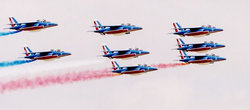Aerobatics
|
|
Soon after aircraft were invented, pilots realised that they could be used as part of a flying circus to entertain people or impress others in what was termed aerobatics. Maneuvers that had no practical purpose were flown for artistic reasons or to draw gasps from onlookers. In due course some of these maneuvers were found to allow aircraft to gain tactical advantage during aerial combat or "dogfights" between two or more fighter aircraft. The word presumably derives from the term used by human gymnasts - acrobatics - to describe exercises designed to impress or build muscle strength.
All aerobatic maneuvers involve rotation of the aircraft about its longtitudinal axis - rolling; or the pitch axis - looping. Some complex maneuvers - such as a spin - also require that the aircraft be displaced around a vertical axis, known as yaw.
Formation aerobatics are usually flown by teams of up to sixteen aircraft, although economic considerations mean that most teams habitually fly between four and ten aircraft. Some are state funded to reflect pride in the armed forces whilst others are commercially sponsored. Coloured smoke trails may be emitted to emphasise the patterns flown and/or the colours of a national flag. Usually each team will use aircraft similar to one another finished in a special and dramatic colour scheme, thus emphasising their entertainment function.
Famous teams include the Brazil Air Force Demonstration Squadron (Esquadrilha da Fumaša), Black Arrows, Blue Angels, Diables Rouges, Frecce Tricolori, Halcones, Patrouille de France, Patrouille Suisse, Red Arrows, Red Pelicans, Rothmans, Silver Falcons, Roulettes, Royal Jordanian Falcons, the USAF Thunderbirds, Snowbirds, the Patrulla Aguila from Spain and the Yellowjacks.
The practice of formation flying might have been inspired by the migration of flocks of birds, swans or geese. Certainly most aerobatic teams include a V-formation in their routines. Teams fly V-formations out of practicality - they can't fly directly behind another aircraft, or they'd get caught in the wake vortices or engine exhaust. Aircraft will always fly slightly below the aircraft in front, if they have to follow exactly in line.
Aerobatic aircraft usually fall into two categories - specialist aerobatic, and aerobatic capable. Specialist designs such as the Pitts Special, the Extra 300/200, and the Sukhoi Su-29 aim for ultimate aerobatic performance, at the expense of general purpose use such as touring, or ease of non aerobatic handling such as landing. At a more basic level, aerobatic capable aircraft can be dual purpose - equipped to carrying passengers and luggage, easy to land, as well as being capable of basic aerobatic figures.
Aerobatics is taught to military fighter pilots as a means of developing precise flying skills and for tactical use in combat.
Aerobatics is also practiced as a sport. Some pilots fly solely for recreation, whilst a smaller number (about 600-800 in the USA) choose to compete in aerobatic competitions. US Competitions start at 'Primary ' level and proceed in complexity through Sportsman, Intermediate and Advanced, with 'Unlimited' being the top competition level. Unlimited pilots perform much more complex figures and sustain higher g levels (+/- 10g).
Military aerobatics are much more limted as jet powered military aircraft cannot take advanatge of the gyroscopic forces that a propellor driven aircraft can exploit. The aerobatic teams also tend to fly in formations which further restricts the manuevers that can be flown.
All aerobatic maneuvers demand proper training regular practice to avoid accidents. Fortunately such accidents are rare and though they can result in fatalities; safety regulations are such that there has not been an airshow spectator fatality in the USA since the 1950s. Low-level aerobatics are extremely demanding and airshow pilots must demonstrate their ability before being allowed to gradually reduce the height at which they may fly their show.
You are most likely to witness aerobatics at a public airshow.
See also:
Template:Modern Aerobatic Teams
|
Lists of Aircraft | Aircraft manufacturers | Aircraft engines | Aircraft engine manufacturers Airports | Airlines | Air forces | Aircraft weapons | Missiles | Timeline of aviation |


